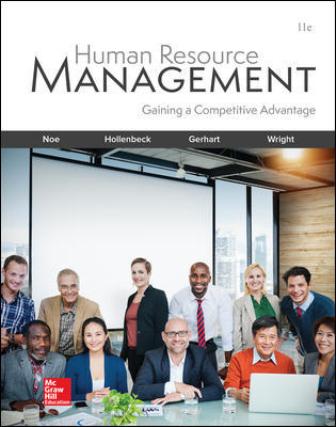Test Bank for Human Resource Management, 11th Edition, Raymond Noe, John Hollenbeck, Barry Gerhart, Patrick Wright
Digital item No Waiting Time Instant Download
ISBN10: 1260076849
ISBN13: 9781260076844
In Stock
Original price was: $75.00.$35.00Current price is: $35.00.
Test Bank for Human Resource Management, 11th Edition, Raymond Noe, John Hollenbeck, Barry Gerhart, Patrick Wright
Human Resource Management, 11e (Noe)
Chapter 4 The Analysis and Design of Work
1) If an organization decides to compete on costs, and hires low-cost labor, it needs to have a decentralized structure to enable autonomy in decision-making by the workers.
Answer: FALSE
Explanation: If a company decides to compete on cost, and hence hire low-cost offshore labor, the jobs have to be designed so that minimally skilled people who will require little training can perform them. The organization in this case needs to have a centralized structure so that low-level workers are not forced into making too many decisions.
Difficulty: 1 Easy
Topic: Introduction
Learning Objective: 04-01 Analyze an organization’s structure and workflow process; identify the output; activities; and inputs in the production of a product or service.
Bloom’s: Remember
AACSB: Analytic
Accessibility: Keyboard Navigation
2) Work-flow design is the process of analyzing the tasks necessary for the production of a product or service, and it is performed after allocating and assigning these tasks to a particular job category or person.
Answer: FALSE
Explanation: Work-flow design is the process of analyzing the tasks necessary for the production of a product or service, prior to allocating and assigning these tasks to a particular job category or person.
Difficulty: 1 Easy
Topic: Work-Flow Analysis and Organization Structure
Learning Objective: 04-01 Analyze an organization’s structure and workflow process; identify the output; activities; and inputs in the production of a product or service.
Bloom’s: Remember
AACSB: Analytic
Accessibility: Keyboard Navigation
3) More and more people use computers to do their work today. As a result, spelling, grammar, and math basic skills are decreasing.
Answer: TRUE
Explanation: New software that is capable of analysis and decision-making can “de-skill” work for employees. Because they become reliant on the software for certain tasks, employees can over time lose these capabilities and are unable to execute them effectively, should the need arise.
Difficulty: 2 Medium
Topic: Work-Flow Analysis and Organization Structure
Learning Objective: 04-01 Analyze an organization’s structure and workflow process; identify the output; activities; and inputs in the production of a product or service.
Bloom’s: Understand
AACSB: Analytic
Accessibility: Keyboard Navigation
4) Micromanagement affects a team’s autonomy.
Answer: TRUE
Explanation: Teams have to be given the autonomy to make their own decisions in order to maximize the flexible use of their skill and time and thus promote problem-solving.
Difficulty: 2 Medium
Topic: Work-Flow Analysis and Organization Structure
Learning Objective: 04-01 Analyze an organization’s structure and workflow process; identify the output; activities; and inputs in the production of a product or service.
Bloom’s: Understand
AACSB: Analytic
Accessibility: Keyboard Navigation
5) For teams to be effective, it is essential that the level of task interdependence is greater than the level of outcome interdependence.
Answer: FALSE
Explanation: For teams to be effective, it is essential that the level of task interdependence (how much they have to cooperate) matches the level of outcome interdependence (how much they share the reward for task accomplishment).
Difficulty: 2 Medium
Topic: Work-Flow Analysis and Organization Structure
Learning Objective: 04-01 Analyze an organization’s structure and workflow process; identify the output; activities; and inputs in the production of a product or service.
Bloom’s: Understand
AACSB: Analytic
Accessibility: Keyboard Navigation
6) The final stage in workflow analysis is to identify the inputs used in the development of a work unit’s product.
Answer: TRUE
Explanation: The final stage in workflow analysis is to identify the inputs used in the development of a work unit’s product. These inputs can be broken down into the raw materials, equipment, and human skills needed to perform the tasks.
Difficulty: 1 Easy
Topic: Work-Flow Analysis and Organization Structure
Learning Objective: 04-01 Analyze an organization’s structure and workflow process; identifying the output; activities; and inputs in the production of a product or service.
Bloom’s: Remember
AACSB: Analytic
Accessibility: Keyboard Navigation
7) Centralization is the degree to which work units are grouped based on functional similarity or similarity of workflow.
Answer: FALSE
Explanation: Centralization is the degree to which decision-making authority resides at the top of the organizational chart as opposed to being distributed throughout lower levels (in which case authority is decentralized).
Difficulty: 1 Easy
Topic: Work-Flow Analysis and Organization Structure
Learning Objective: 04-01 Analyze an organization’s structure and workflow process; identify the output; activities; and inputs in the production of a product or service.
Bloom’s: Remember
AACSB: Analytic
Accessibility: Keyboard Navigation
8) Due to their workflow focus and proximity to a homogeneous consumer base, divisional structures tend to be less flexible and innovative.
Answer: FALSE
Explanation: Due to their workflow focus and their proximity to a homogeneous consumer base, divisional structures tend to be more flexible and innovative.
Difficulty: 2 Medium
Topic: Work-Flow Analysis and Organization Structure
Learning Objective: 04-01 Analyze an organization’s structure and workflow process; identify the output; activities; and inputs in the production of a product or service.
Bloom’s: Understand
AACSB: Analytic
Accessibility: Keyboard Navigation


Reviews
There are no reviews yet.